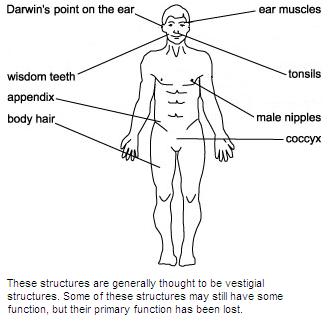 Education
Education
Vestigial Arguments About Vestigial Organs Appear in Proposed Texas Teaching Materials
As documented in our Texas report, the evolution-related instructional materials proposed for use in Texas don’t just contain errors about the origin of life or embryology. Some of the publishers also proposed materials that make inaccurate claims about vestigial organs and the evidence for common ancestry.
One curriculum even resuscitates long-debunked claims that the coccyx, appendix, tonsils, and many other functional organs are “vestigial,” failing to mention that these organs are now recognized to have important functions (e.g. appendix, coccyx, tonsils, etc.) or are not generally regarded as evolutionary holdovers (e.g. male nipples).
What Does the Evidence Say about Vestigial Organs?
Textbooks often present purportedly vestigial organs as evidence for common descent. The appendix is probably the most commonly cited organ which is purportedly an evolutionary holdover from our quadruped ancestors. Other allegedly vestigial organs that appear in textbooks include tonsils, the coccyx, or male nipples.
These popular arguments for evolution from vestigial organs are highly inaccurate. For example, the appendix serves as a storehouse for probiotics and also provides a variety of immune-related functions, helping to produce and train white blood cells, as well as playing an important role during fetal development. In light of this evidence, Duke University immunologist William Parker observed that “Many biology texts today still refer to the appendix as a ‘vestigial’ organ” and thus “it’s time to correct the textbooks.”
In addition to the appendix, examples of structures previously considered to be vestigial include:
- The tonsils: At one time, they were routinely removed. Now it’s known they serve a purpose in the lymph system to help fight infection.
- The coccyx (tailbone): Rather than being vestigial, this is a vital bone required for the human bipedal body plan. It is used for the attachment of muscles, tendons, and ligaments which support the bones in our pelvis.
- Male nipples: Even under an evolutionary paradigm, male nipples are not an evolutionary holdover. They are a simple consequence of the mammalian body plan and development, and are not considered ‘vestigial’.
Textbooks rarely inform students about the important functions of these allegedly vestigial organs and instead simply cite them as evidence for common ancestry.
What Do Proposed Supplemental Materials in Texas Say?
As noted, publishers have proposed instructional materials to the Texas State Board of Education that present inaccurate, misleading, or one-sided information about vestigial organs. By doing so, these publishers have failed to follow state science curriculum standards, which call for materials that help students “analyze, evaluate, and critique scientific explanations by using empirical evidence, logical reasoning, and experimental and observational testing, including examining all sides of scientific evidence of those scientific explanations, so as to encourage critical thinking by the student.”
Here is a run-down of the inaccurate information presented:

Apex Learning
In a section titled “Evidence for Evolution,” materials submitted by Apex Learning make long-debunked popular arguments for evolution from vestigial organs. The materials claim that the coccyx, appendix, tonsils, and many other functional organs are “vestigial” but fails to mention that these organs have important functions (e.g. appendix, coccyx, tonsils, etc.) or are not evolutionary holdovers (e.g. male nipples). The diagram below shows these claims:
School Education Group (McGraw Hill)
This publisher shows the appendix and states “Vestigial structures are structures that are reduced forms of functional structures in other organisms” and “Evolutionary theory predicts that features of ancestors that no longer have a function for that species will become smaller over time until they are lost.”
As noted, Duke University immunologist William Parker observed that “Many biology texts today still refer to the appendix as a ‘vestigial’ organ” and thus “it’s time to correct the textbooks.” Hopefully this will happen in Texas.
